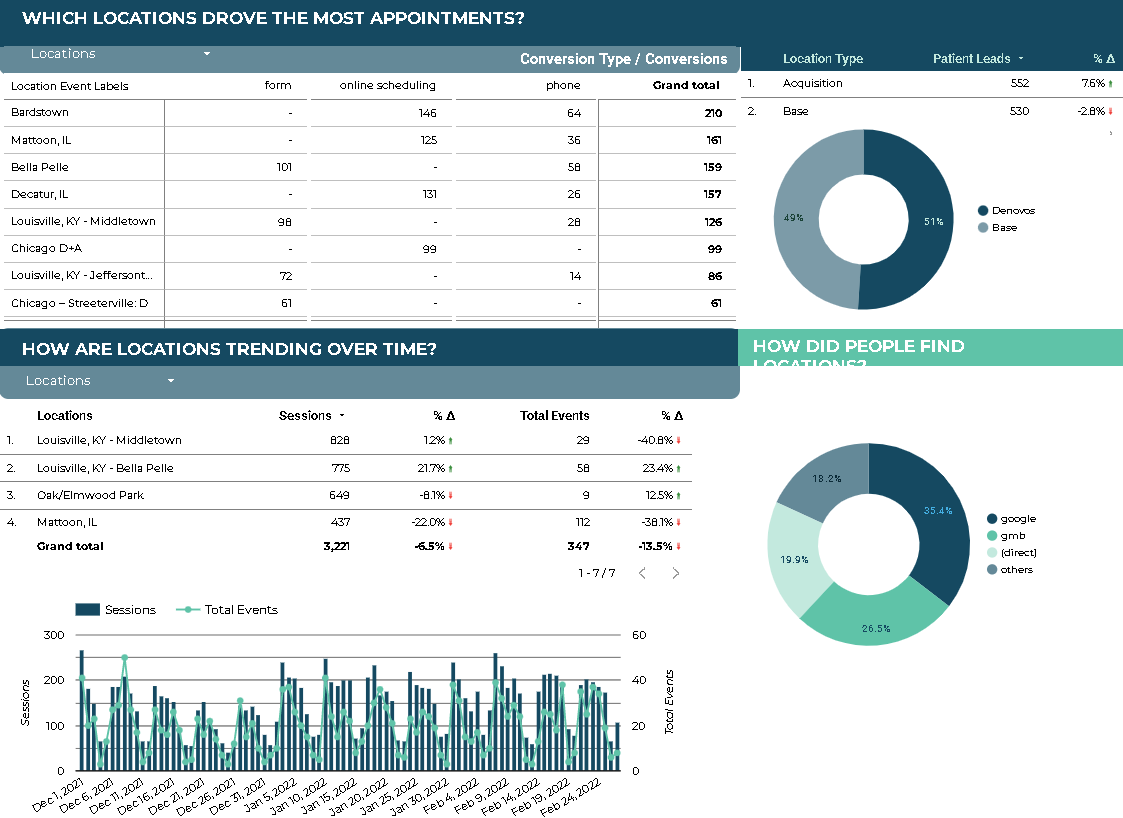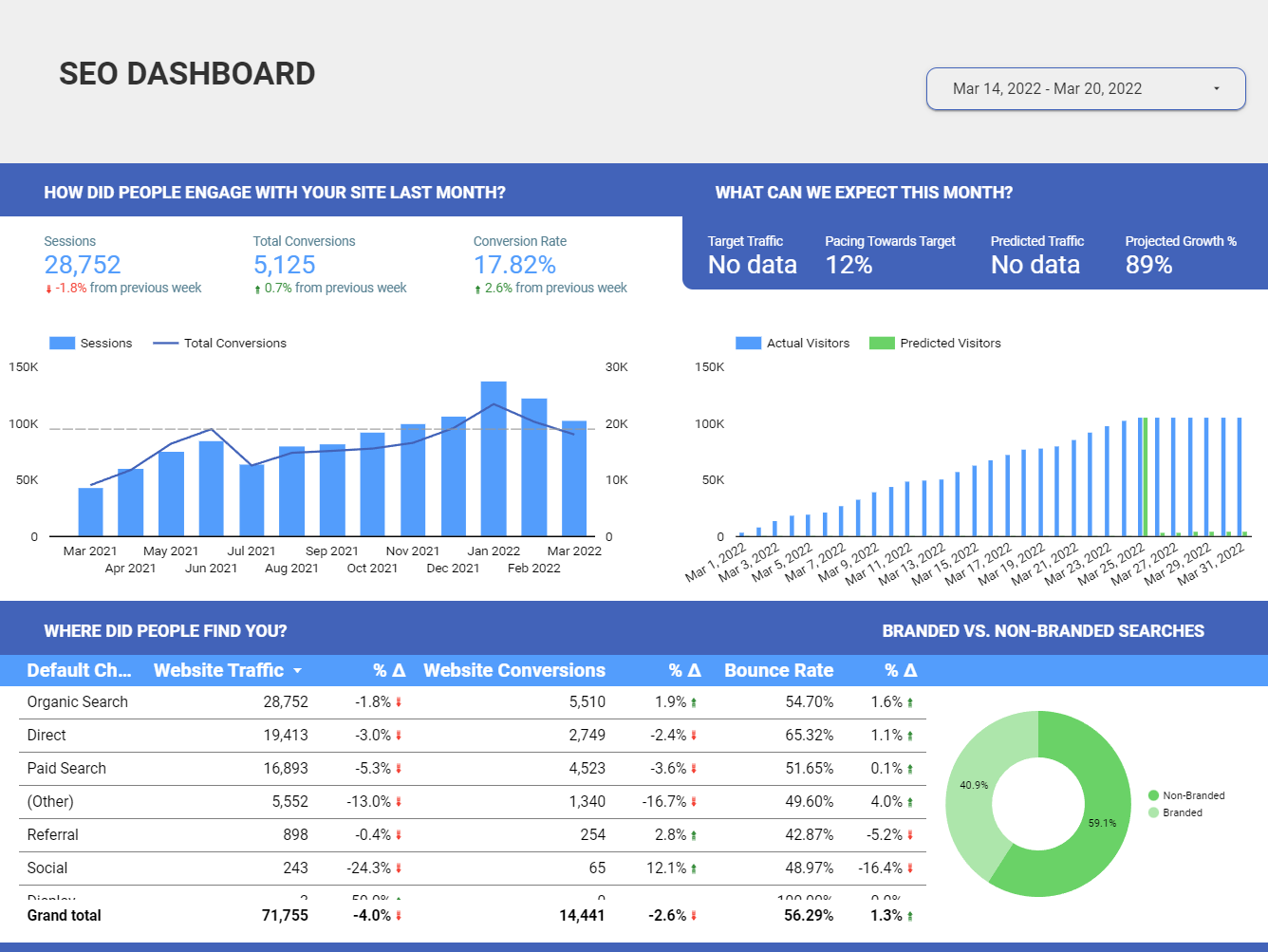Reality check: scalable digital growth isn’t possible without a plan for evaluating performance. This is especially true of multi-location brands, who must measure and compare SEO performance between locations, brands, and regions. This article outlines three essential steps that will help you measure SEO performance across different regions.
Table of Contents
To accurately evaluate performance for multi-location brands, you need to be able to drill into key performance indicators (KPIs) at specific regions/locations. Without this information, you won’t know if you are maintaining performance as you grow.
Step 1. Establish Consistent KPIs
KPIs can vary based on what is most important to key stakeholders. Typically we bucket metrics into three main categories:
Visibility
Common examples of visibility metrics:
- Local keyword rankings for high-priority brand and non-brand queries
- Google Business Profile (GBP) views for each listing
- Yext views for business listings outside of Google
- Google Search Console (GSC) impressions for sitewide SERP views
SERP Actions
Common examples of SERP actions worth tracking:
- Customer actions on GBP, i.e., phone calls, direction requests, and website visits coming through Google listings
- Referral traffic from off-site listings (note: you can use UTM parameters to ensure you track all of this consistently within Google Analytics!)
- GSC clicks for organic listings
Conversions
By far the most crucial KPI with regard to SEO. For most healthcare brands, the most important conversion is the booking of an online or phone appointment. By tracking all of the higher-funnel actions above, you’ll get a stronger sense of what channels your patients are coming from and where you should be marketing more strategically (to create higher quality conversions).
Pro tips: Setting up click-to-call conversion tracking is one of the most important methods of tracking the effectiveness of a local SEO strategy. The client may not realize that an increase in phone calls could be related to an optimized online presence.
Additionally, an increased conversion rate is always good to see when rolling out local SEO optimizations. It can be a little scary to see traffic drop, but if the conversion rate is still up, you’re still reaching your target local audiences.
Finally, one of the more obvious KPIs to keep track of is the average Google reviews over time. This can make or break a local company’s presence in the Map Packs, so staying on top of reviews is crucial.
Step 2. Choose & Use the Right Analytics Tools
There are a million analytics tools out there, so let’s focus on four essentials:
Google Business Profile (formerly Google My Business/GMB)
Google generates more than 8 billion searches per day, so it’s absolutely crucial to be visible across the entire SERP—including within the Map Pack/Local Pack and your business’s Google listing. Healthcare brands need to appear both within the organic listings and local listings to maximize their exposure to potential patients.
“Typically, I recommend monitoring an increase in Total Actions on your GBP listings,” says Sam Brown, our Junior SEO Specialist. “This includes phone calls, direction requests, and most importantly, website visits. Total views are also important, but I’d much rather see an increase in interactions, as this means we’re reaching the people who need the services (regardless of a drop in views).”
Remember that interaction numbers are closely correlated with brand vs. non-brand search impressions. Our team loves to see an increase in non-brand impressions, as this means that the client has been appearing on more general, information-seeking local searches (rather than the person simply looking up the business by name).
Google Analytics
Google Analytics (GA) is usually the primary source of truth for your website data, and it has many valuable tools explicitly meant for locally-focused businesses.
For local-focused businesses, geographic reports shine a light on where your traffic is coming from. That is, are you bringing in traffic from correct and serviceable locations? For example, if you service a certain area and you’re seeing site traffic come from an area more than 30 miles away, you’ll want to update your on-site SEO strategy so that it focuses specifically on the area you service.
You can do this by adding more targeted location language on your website and location page. You can also cross-reference this data with impressions in GSC or query reports in GBP. Look for which searches are landing people on your website. Is there value you can provide to those users even if they’re far away from your office?
On the other hand, geo reports can also open doors to unexpected serviceable areas. If your geo report reveals traffic from a serviceable area that you’re not currently targeting, you may have an opportunity to take advantage of a new market, which you can then target through web copy, GBP optimizations, and more.

Local Falcon
Local Falcon is a lesser-known tool that helps you see your average ranking within a set radius around your business location. Similar to a GA geo report, this data can help you determine which local markets need a more strategic approach in order to generate demand.
“Compare your Local Falcon ranking results to your competitors to identify where they’re ‘out-optimizing,’” says our guy Sam Brown. “Do they have more or better reviews? Are they simply closer in proximity to the search point? Do they utilize categories or keywords in their GBP listing that you can emulate? You can also run trend reports over time to see how your listing improves in ranking as you make improvements.”
SEMRush
While Local Falcon is a nice supplement for competitive research, SEMRush is essential for comprehensive rank tracking and keyword research. Use SEMrush keyword research tools to identify the most valuable keywords in your market, then load those into projects per location to track rankings specifically in your locale.
Step 3. Understand the Challenges for Multi-Location and Regional SEO
As you grow and expand into new locations, you’re likely to encounter three main challenges with respect to SEO:
Challenge 1: Which Regions/Locations Should We Prioritize?
Every location is unique and requires different tactics when it comes to driving organic traffic. It’s important to know which specific markets are interested in which specific service offering. Using geo reports in Google Analytics and local search volume from SEMrush, you can see where traffic and conversions are coming from at country, state, and city levels.
By understanding where most users are coming and converting from, we can optimize appropriately by focusing on location-specific keywords, implementing local business schema, creating an optimized Google listing, and more.
Challenge 2: How Do Target Keywords Differ From One Location to Another?
For multi-location businesses, competitor research is crucial when analyzing performance for multiple different regions.
Search varies from location to location, so you need to figure out what queries look like in different places. By identifying competitors in each of your target regions and understanding how SERPs change from location to location, you can then create location pages that rank well in your target areas.
Challenge 3: How Do We Track KPIs And Implement Optimizations At Scale?
You’ll find that tracking a large number of keywords, for a large number of locations, quickly becomes complicated. The first step is to prioritize your markets! Begin your optimization strategy with 1-10 core markets and use them as a testing ground. Analyze their performance over a several-month period, before rolling out any findings across additional location pages or local listings.
Secondly, prioritize your keyword targets and/or services. You can’t focus on all things at once. Just as you do with markets, choose a strategic selection of keywords to drill into for tracking purposes. Make sure you’re considering local and national search volume, as well as business value/relevance and difficulty.
Lastly, set up robust (automated) dashboards that actually allow you to see all of your data at once. We’ve mentioned several tools and strategies, but using disparate sources can be overwhelming and lead to gaps in data. We use Google Data Studio (GDS) to blend and aggregate data sources like SEMrush, Google My Business, GA, and GSC so that we can quickly identify wins and opportunities.

Using drill-down reports and location filters, we can see all markets at once or focus on a specific region within the same dashboard. GDS will also dynamically update, so you don’t have to worry about re-pulling data or seeing outdated information.
Building A Scalable SEO Framework
With respect to the steps I’ve detailed above, there’s a caveat. Few multi-location groups go through steps, dust off their hands, and move on. Rather, this is a continuous process, one that you ought to improve and optimize as you continue expanding to new locations.
With that in mind, it’s useful to view this multi-location SEO strategy as a repeatable framework—a living and breathing structure you can rely on to sustain growth. Because without the right metrics, tools, and understanding of the challenges, you’ll fail to achieve sustainable growth.

